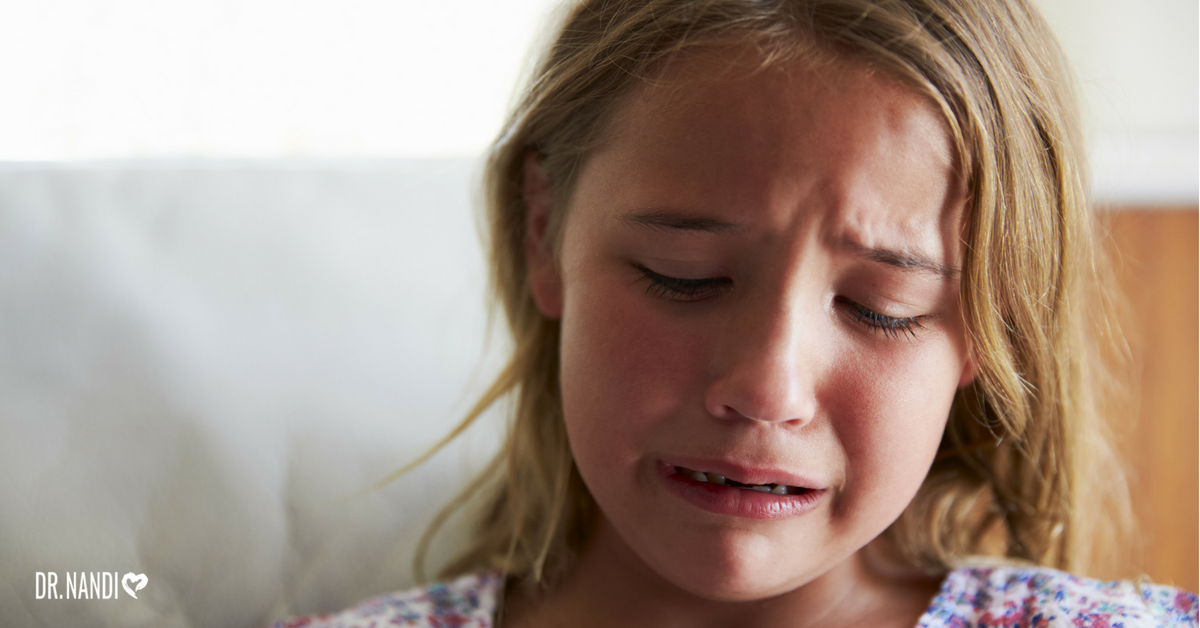Anxiety can be a crippling burden sometimes, and it can show up in many forms including headaches, sweating, trembling, excessive worrying, rapid breathing and increased heart rate, feeling tired, difficulty concentrating or just feeling nervous, restless or irritable.
Most of us worry from time to time. But when we carry the worry around everywhere we go, it can weigh us down like a heavy backpack and make it difficult to live life in the way that we would like. Our children are not immune to anxiety. In fact, they can be even more susceptible to it. It is estimated that 25% of teens in the U.S. will fit the criteria for an anxiety disorder at some time, are the most anxious age range in our society and are more anxious than their peers in the rest of the world.
I believe there are many factors that go into this alarming statistic. There are a few that I’d like to highlight here, along with suggestions for you to help them manage their anxiety.
How to Manage Anxiety
1. Just Turn it OFF
In our modern society, we cannot stop children from hearing about world events, even the upsetting ones. But we don’t have to dwell on them the way 24/7 news shows would have us do. Odds are that our children are going to learn about current events. Therefore, it is important for us to explain to them, at their developmental level what happened and find ways to help them to still feel safe
2. Get Their Zzzzz’s
The rise of so many devices in our lives has made bedtime a trickier process. Kids just want to play one more game, one more level, check one more update or watch just one more YouTube video. First, I encourage parents to apply a blue light filter to all devices (including their own). For a PC, there is software called f.lux that filters out blue light at either sunset to sunrise, or at the time you set it. Apple products have a setting called NightShift that functions the same way. The blue light from our devices can suppress melatonin production. This is an important hormone that our bodies secrete to help us fall asleep and stay asleep.
For older kids, most high schools begin earlier than teen bodies are ready. Teens are tempted to use social media later and later to stay connected to friends and not “miss out.” You can set a reasonable time for disconnecting from devices and social media and there are even programs such as ParentKit where you can turn off access to WiFi or to social media after a certain time each night. In addition, many cell phone providers allow us to turn off these devices at a certain time.
Don’t allow screens to stay in their bedrooms overnight. Create a central charging station for all devices so children know where to put them at the end of the day.
Rather than laying down strict policies and dropping the hammer on our children (especially older ones), I encourage parents to work together to collaborate and compromise on terms that both parent and child can live with. When we get their buy-in, it is much more likely that they will honor what we have agreed upon than if we keep them out of the process entirely. Thus, we are working as a team rather than it being about us vs. them.
3. FOMO and Social Media
Modern society has brought social media into our lives and our kids.’ Even if they don’t have social media accounts, they surely know about it. Most of their friends likely have profiles on various platforms. Being on social media can be very tricky for young people who are just trying to figure out who they are, what they stand for, and what they like and don’t like, at the same time they are trying to form an identity that is separate from their parents. And adding in the inevitable comparison-machine of these various platforms can make navigating all of these emotions extremely difficult for our kids.
This is where communication becomes vital. I’m talking about expressing genuine curiosity in what they are doing online, not coming from a place of suspicion or control or fear. When we have true open communication with our children, we can help them to navigate these confusing waters. But this takes time to develop and work on our part.
The inevitable truth about social media these days is that most kids communicate via these platforms. If our kids are on them, they are at risk of feeling left out or getting feelings hurt. And if they are not on them, they are at risk of not only feeling but actually being left out of all the group communication that goes on inside these platforms. Neither option is ideal.
What is a Parent to do?
How can we best help our children? If we allow them to have social media profiles, it is imperative that we teach our kids HOW TO USE social media instead of being USED BY social media. Social media is undoubtedly a powerful way to stay in touch with people both near and far. To communicate, collaborate and coordinate many facets of our lives. But we must help our children to see that before and beyond social media, they are a precious, unique person who is just as valuable as every single other person on this planet.
4. Social Media for Connection, not comparison
We must help them to use social media as a tool of connection. Not a weapon of comparison, measurement or judgment against their peers, which can leave them feeling less-than. Most people on social platforms only share their “highlight reels.” This can leave us feeling like our lives don’t measure up to what we see on their profiles. But they are not sharing with us their sleepless nights, their chicken pox, or their painful breakups. It is important our children understand that, but we must make sure that WE understand it first.
5. Lighten up the School Focus
This can be a touchy subject for parents and for kids, but it must be stated. As parents, we often place too much emphasis on grades and performance in school. And most often it comes from a place of fear within us, which can then rub off onto them. We may fear them not getting into the advanced class, the award, scholarship or the top college. This can lead to anxiety in our children in the Race to Nowhere, and ultimately burnout, discontentedness in their lives and anxiety.
As parents, we do best for our children when we focus on the process (how hard they worked, how much they learned, how engaged they are in the material) rather than the outcome (the final grade). There is no greater gift we can offer our children than to help them discover their gifts and passions. Then support them to go after their passion in life. This will serve them and humanity as they share their gifts with the world in their own unique and amazing ways.
6. The Gut-Brain Connection
A lot of my knowledge about anxiety came not only from my formal education, but also from the education I gained with my daughter. She is wired for anxiety. That much has been clear most of her life. It flared up when she was eight and we got a handle on it back then. One of the many steps we took to help her was taking her to a holistic medicine practitioner who is trained in both eastern and western medicine. He helped me to understand the connection between our guts and our brains. We removed certain foods to which she was sensitive, and she began taking supplements to heal her gut. This allowed her body to be more effective at making the neurotransmitters in our bodies that keep anxiety at bay.
7. Take a Breather
We also taught her deep-breathing exercises. When we focus on our breath, our bodies naturally calm down. One of the easiest exercises is called Box Breathing, where you close your eyes, inhale to a count of four, hold your breath for a count of four, exhale for a count of four and wait to a count of four before breathing in again. When I practice this, I close my eyes and imagine drawing the line of the box up the left side with the inhale, across the top while I hold my breath, down the right side while I exhale, and across the bottom while I wait to inhale again. This is a powerful tool that our children can use…and we can too!
8. Just Throw it Out
My daughter also sleeps with a fan in her room. When her worries would trouble her when she was younger, she would “pull” the worries out of her head. Then she would “throw” them into the fan, imagining them getting crushed into pieces when they went into the fan. This really helped her to release her fears and worries.
9. Keep a Lid on It
One other technique we used was to keep a “Worry Jar” near her bed. This was a plastic bug-catching jar with a screw-on lid. Each night, if she was feeling worried about something, I would unscrew the cap and she would tell me what was worrying her. Then she would “pull” the worry out and stuff it into the jar. After she was finished emptying her mind of all of her worries, I would screw the lid back on. Then we would say a prayer asking God to empty the jar of her worries while she slept. When she woke up each morning, without fail, the jar would be empty.
10. Release the Worry
We can also teach children, especially older ones, to write their fears and anxieties down. This helps them release them from their troubled minds and store them in paper or journal. This releases from their bodies. They can also tell the worries after they write them out that they have the day off.
11. What is the worst that could happen?
Tim Ferriss has a wonderful TED talk about fear and anxiety. He encourages us to do an exercise where we imagine what is the worst that could happen when we are worried about a situation. Many times, we find that our anticipation of the event turns out to be far more troubling than the actual event.
A Final Thought on Anxiety
Modern society tempts us to live our lives as if we are running on a treadmill at high speeds. However, this is not beneficial to us. It is important that we take time to slow down. Take a good look at our lives and the lives of our children. Make sure we are making decisions and choices that support us to live our best lives, anxiety-free to the greatest extent possible. I have created a worksheet to help you recognize and address anxiety in your child which you can get here.
Erin Taylor is a mom, parent coach, and author of Connection and Kindness: The Key to Changing the World through Parenting. Her podcast, Powerful Parenting for Today’s Kids is enjoyed by parents around the world. Erin was able to take the tragedy of the death of her infant daughter and turn it around to not only survive, but thrive, and help others to do the same. You can learn more about her at www.erin-taylor.com.



















